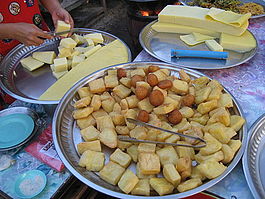This article includes a list of general references, but it lacks sufficient corresponding inline citations. (February 2013) |
 To hpu (Burmese tofu), in two forms: fresh and fritters | |
| Place of origin | Burma |
|---|---|
| Associated cuisine | Burmese cuisine |
| Main ingredients |
|
Burmese tofu (Burmese: တိုဖူး, pronounced [tòpʰú]; or Burmese: တိုဟူး, pronounced [tòhú]) is a food of Shan origin and of Chinese from Yunnan Province, made from water and flour ground from yellow split peas and the Burmese version of chickpea flour, also known as besan flour, in a fashion similar to polenta.[1] The flour is mixed with water, turmeric, and a little salt and heated, stirring constantly, until it reaches a creamy consistency. It is then transferred into a tray and allowed to set. It can also be made using dried chickpea instead of processed flour. In this process, dried chickpeas are soaked overnight. Once the peas have been re-hydrated, they are ground into a puree with some of the liquid used to soak the peas, then allowed to set for a couple of hours. Much of the top layer of clear liquid is then skimmed off and the remaining puree is brought to a boil with turmeric and salt and cooked and set in the same manner as the version using chickpea flour. It is matte yellow in colour, jelly-like but firm in consistency, and does not crumble when cut or sliced. It may be eaten fresh as a Burmese tofu salad or deep-fried into a Burmese fritter.[2] It may also be sliced and dried to make crackers for deep frying. Despite the name, Burmese tofu is unrelated to Chinese tofu,[3] which is made from soy milk with added coagulants.
- ^ Also called gram flour, besan flour is made from chana dal (also called kala chana or Bengal gram), a type of small, dark-colored chickpea also used in Indian cuisine).
- ^ Nguyen, Andrea (2012-02-28). Asian Tofu: Discover the Best, Make Your Own, and Cook It at Home [A Cookbook]. Potter/TenSpeed/Harmony. ISBN 978-1-60774-242-5.
- ^ Aye, MiMi (13 June 2019). Mandalay: Recipes and Tales from a Burmese Kitchen. Bloomsbury Publishing. ISBN 9781472959485.